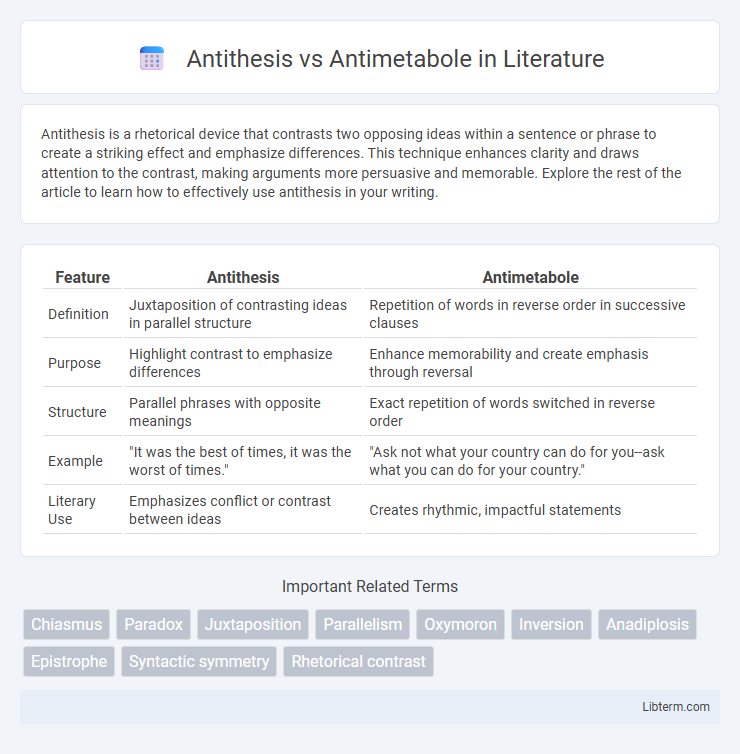Antithesis is a rhetorical device that contrasts two opposing ideas within a sentence or phrase to create a striking effect and emphasize differences. This technique enhances clarity and draws attention to the contrast, making arguments more persuasive and memorable. Explore the rest of the article to learn how to effectively use antithesis in your writing.
Table of Comparison
| Feature | Antithesis | Antimetabole |
|---|---|---|
| Definition | Juxtaposition of contrasting ideas in parallel structure | Repetition of words in reverse order in successive clauses |
| Purpose | Highlight contrast to emphasize differences | Enhance memorability and create emphasis through reversal |
| Structure | Parallel phrases with opposite meanings | Exact repetition of words switched in reverse order |
| Example | "It was the best of times, it was the worst of times." | "Ask not what your country can do for you--ask what you can do for your country." |
| Literary Use | Emphasizes conflict or contrast between ideas | Creates rhythmic, impactful statements |
Introduction to Antithesis and Antimetabole
Antithesis employs contrasting ideas placed side by side in parallel structures to emphasize differences and create a balanced effect, often seen in phrases like "It was the best of times, it was the worst of times." Antimetabole involves the repetition of words or phrases in reverse order to highlight a statement's paradox or meaning, exemplified by "Ask not what your country can do for you--ask what you can do for your country." Both rhetorical devices enhance persuasion and memorability by playing with syntax and meaning, but antithesis focuses on opposition in ideas, while antimetabole centers on the reversal of word order.
Defining Antithesis: Meaning and Purpose
Antithesis is a rhetorical device that contrasts two opposing ideas within a balanced structure, emphasizing their differences to create a striking effect. Its purpose is to highlight conflict, clarify choices, or provoke thought by presenting juxtaposed concepts in parallel form. This technique enhances persuasion and memorability in speeches, literature, and everyday communication.
Understanding Antimetabole: Structure and Function
Antimetabole is a rhetorical device that reverses the order of words in two parallel phrases to create a memorable and impactful statement, as seen in the phrase "Ask not what your country can do for you; ask what you can do for your country." This structure emphasizes contrast and irony by repeating words in inverted order, enhancing persuasiveness and clarity. Unlike antithesis, which contrasts ideas without necessarily reversing word order, antimetabole uses precise word inversion to reinforce the message's symmetry and rhythm.
Key Differences Between Antithesis and Antimetabole
Antithesis juxtaposes contrasting ideas in parallel structures to highlight differences, such as "It was the best of times, it was the worst of times." Antimetabole repeats words in reverse order for emphasis and rhetorical effect, exemplified by "Ask not what your country can do for you; ask what you can do for your country." The key difference lies in antithesis focusing on contrast of ideas, while antimetabole emphasizes a reversal of word order.
Historical Origins and Literary Contexts
Antithesis originated in classical rhetoric during ancient Greek and Roman times, used to create a clear contrast by placing opposing ideas in parallel structures, exemplified in Cicero's speeches. Antimetabole, also rooted in classical antiquity, specifically involves the repetition of words in reverse order to emphasize a point, famously employed by figures such as Aristotle and later by John F. Kennedy. Both devices appear prominently in literary texts and speeches, serving distinct functions: antithesis highlights opposition, while antimetabole enhances memorability and rhetorical impact through its mirrored phrasing.
Famous Examples of Antithesis in Literature
Antithesis is a rhetorical device that juxtaposes contrasting ideas in a balanced structure, exemplified by Charles Dickens' "It was the best of times, it was the worst of times" from *A Tale of Two Cities*. Antimetabole, by contrast, involves repeating words in reverse order, as seen in John F. Kennedy's famous phrase, "Ask not what your country can do for you--ask what you can do for your country." The powerful use of antithesis in Shakespeare's *Julius Caesar*, such as "Not that I loved Caesar less, but that I loved Rome more," highlights the tension between conflicting loyalties in literature.
Memorable Instances of Antimetabole in Rhetoric
Antimetabole, a rhetorical device involving the repetition of words in reverse order, creates memorable and impactful statements such as John F. Kennedy's "Ask not what your country can do for you--ask what you can do for your country." Unlike antithesis, which contrasts ideas, antimetabole emphasizes balance and symmetry to reinforce a point effectively. Historical speeches and literature often use antimetabole to leave lasting impressions through rhythmic and mirrored phrasing.
Effects on Audience: Persuasion and Memorability
Antithesis creates a contrast between opposing ideas, enhancing clarity and emphasizing key points, which strengthens persuasion by highlighting differences and driving home the argument. Antimetabole, by repeating words in reverse order, increases memorability through rhythmic structure and clever wordplay, making messages more impactful and easier to recall. Both devices engage audiences effectively, with antithesis appealing to logic and antimetabole appealing to linguistic creativity, boosting overall retention and persuasive power.
When to Use Antithesis vs. Antimetabole
Use antithesis to highlight contrast between opposing ideas within parallel structures, enhancing clarity and emphasis in persuasive or argumentative writing. Choose antimetabole when aiming for a memorable, rhetorical effect by reversing word order in successive clauses, often to underscore irony or a paradox. Understanding context and desired impact helps determine whether the clear opposition of antithesis or the striking repetition of antimetabole best strengthens your message.
Conclusion: Choosing the Right Device for Impact
Antithesis employs contrasting ideas within parallel structures to highlight differences and create a striking effect, while antimetabole repeats words in reverse order to emphasize a point through symmetry. Selecting the right rhetorical device depends on the intended impact: antithesis sharpens opposition, whereas antimetabole reinforces a concept with memorable repetition. Understanding the nuances of these devices enables effective communication that resonates and persuades audiences.
Antithesis Infographic

 libterm.com
libterm.com